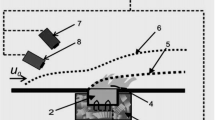Abstract
The experimental values of the flammability limits in hydrogen-oxygen-inert diluent (helium argon, carbon dioxide, steam) mixtures at temperatures up to 523 K and pressures up to 2 MPa as well as of the burning velocities of H2−O2−N2 mixtures at 293 K and 4 MPa are reported. An anomalous effect of helium on the lower flammability limit in a hydrogen-oxygen-helium mixture is shown. The synergistic effect observed for helium-carbon dioxide and helium-steam mixtures used as inert retardants is noted. The data are interpretea theoretically on the assumption of the important role of the selective diffusion of hydrogen and helium from the initial mixture to the flame.
Similar content being viewed by others
References
H. F. Coward and G. W. Jones, “Flammability limits of gases and vapors,” Bull. 503, U. S. Bureau of Mines, Washington (1952).
Yu. N. Shebeko, A. B. Il'in, and A. V. Ivanov, “An experimental study of flammability limits in hydrogen-oxygen-diluent mixtures,” Zh. Fiz. Khim.,58, No. 4, 862–865 (1984).
R. K. Kumar, “Flammability limits in hydrogen-oxygen-diluent mixtures,” J. Fire Sci.,3, No. 4, 245–262 (1985).
G. S. Holmstedt, “The upper limit of flammability of hydrogen in air, oxygen, and oxygen-inert mixtures at elevated pressures,” Combust. Flame,17, No. 4, 295–301 (1971).
S. M. Kogarko, A. G. Lyamin, O. E. Popov, et al., “Determination of flame propagation limits in stoichiometric oxyhydrogen mixtures with steam,” in: Hydrogen Behavior and Control and Related Containment Loading Aspects, Proceedings of a specialists' meeting organized by the International Atomic Energy Agency and held in Suzdal, USSR, 19–23 September 1983, IAEA (1984), pp. 37–41.
S. M. Kogarko, A. Yu. Kusharin, A. G. Lyamin, et al., “Flammability limits in oxyhydrogen gas-diluent mixtures at elevated presusres” in: Explosion Safety of Processes and Fire and Explosion Defense of Equipment and Buildings [in Russian], NIITÉKhIM, Cherkassy (1985), pp. 7–8.
Yu. N. Shebeko, A. Ya. Korol'chenko, S. G. Tsarichenko, et al., “The influence of initial pressure and temperature on the combustion of hydrogen mixtures,” Fiz. Goren. Vzryva,25, No. 3, 32–36 (1989).
S. G. Tsarichenko, M. A. Serkin, and A. V. Trunev, “The influence of pressure and temperature on flammability limits in hydrogen mixtures,” in: Fire and Explosion Hazard of Materials, Products, and Processes [in Russian], VNIIPO, Moscow (1990), pp. 122–124.
S. G. Ssarichenko, Yu. N. Shebeko, A. V. Trunev, et al., “Determination of flammability limits in hydrogen mixtures with inert retardants,” Khim. Promyshl., No. 10, 590–592 (1991).
A. L. Camp, J. C. Cummings, M. P. Sherman, et al., Light Water Reactor Hydrogen Manual, NUREG/CR-2726. SAND 82-1137, Sandia National Laboratory, Albuquerque (1983).
D. D. S. Liu and R. Mac Farlane, “Laminar burning velocities of hydrogen-air and hydrogen-air-steam flames,” Combust. Flame,49, No. 1/3, 59–71 (1983).
T. Iijima and T. Takeno, “Effects of temperature and pressure on burning velocity,” ibid.,65, No. 1, 35–43 (1986).
V. S. Babkin and A. V. V'yun, “Inhibition of hydrogen-air flames under elevated pressures,” Fiz. Goren. Vzryva,17, No. 5, 8–13 (1981).
Yu. N. Shebeko, S. G. Tsarichenko, A. Ya. Korolchenko, et al., “Combustion characteristics of hydrogen-methane-air mixtures in closed vessels,” ibid.,27, No. 6, 52–56 (1991).
J. Warnatz, “Concentration-, pressure and temperature dependence of the flame velocity in hydrogen-oxygen-nitrogen mixtures,” Combust. Sci. Technol.,26, No. 3/4, 203–213 (1981).
F. Behrendt and J. Warnatz, “The dependence of flame propagation in H2−O2−N2 mixtures on temperature, pressure and initial composition,” Int. J. Hydrogen Energy,10, No. 11, 749–755 (1985).
V. S. Babkin, V. V. Zamashchikov, A. M. Badalyan, et al., “The influence of tube diameter on the propagation limits of homogeneous gas flames,” Fiz. Goren. Vzryva,18, No. 2, 44–52 (1982).
E. A. Kudryavtsev, V. N. Krivulin, A. N. Baratov, et al. “A new apparatus for determining flammability limits,” in: Fire and Explosion Hazard of Materials [in Russian], VNIIPO, Moscow (1982), pp. 98–101.
S. A. Yantovskii and M. V. Chernyak, “Flammability limits of hydrogen-oxygen mixtures at superatmospheric pressures,” Zh. Fiz. Khim.,40, No. 11, 2899–2901 (1966).
A. L. Furno, E. B. Cook, J. M. Kuchta, et al., “Some observations on near-limit flames,” in: Procs. 13th Symp. (Int.) on Combustion, The Combustion Institute, Pittsburgh (1971), pp. 593–599.
V. V. Mol'kov, V. N. Bukharov, V. S. Babkin, et al., “Determination of burning velocity by solving the reverse problem in a constant volume bomb,” in: Fire Safety [in Russian], VNIIPO, Moscow (1986), pp. 37–48.
V. T. Monakhov, Methods for Investigating the Fire Hazard of Materials [in Russian], Khimiya, Moscow (1979).
Ya. B. Zeldovich, G. I. Barenblatt, V. B. Librovich, et al., Mathematical Theory of Combustion and Explosion [in Russian], Nauka, Moscow (1980).
A. N. Baratov, “New methods of fire-fighting,” Zh. VKhO im. D. I. Mendeleeva,21, No. 4, 369–379 (1976).
Additional information
VNIIPO, 143900 Balashikha. Translated from Fizika Goreniya i Vzryva, Vol 30, No. 2, pp. 51–57, March–April, 1994.
Rights and permissions
About this article
Cite this article
Shebeko, Y.N., Tsarichenko, S.G., Trunev, A.V. et al. The influence of inert retardants on the combustion of hydrogen-oxygen mixtures under elevated temperatures and pressures. Combust Explos Shock Waves 30, 183–188 (1994). https://doi.org/10.1007/BF00786125
Received:
Revised:
Issue Date:
DOI: https://doi.org/10.1007/BF00786125



